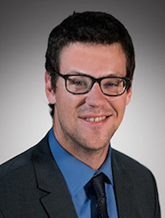
July is Sarcoma Awareness Month. Sarcoma is a broad term that refers to over 50 rare cancers that form in the bones or soft tissues of the body. They are rather diverse, too. The cancers can grow in the fat cells, muscles, cartilage, and other connective tissues of the body.
Sarcoma can be caused by prior radiation or an underlying genetic predisposition, but most of the time it is the result of a random cellular mutation. Jacob Stein, MD, an assistant professor in the Department of Medicine’s Division of Oncology, sees patients who have sarcomas of the bone and soft tissue.
As with many other cancers, early detection is key.
“These are rare tumors”, said Stein. “If a patient goes to a doctor with a new tumor or mass, many doctors may not be thinking of something rare like sarcoma. If you are experiencing a new symptom that’s not going away, stick with it and keep following up until it is looked into. Early detection is really key, so that we can treat these at an early stage and remove them surgically.”

Stein is particularly interested in how oncologists can improve the quality of care that they are delivering to pediatric and young adult sarcoma patients.
“It’s a really unique population to be dealing with cancer at a young age,” said Stein. “We’re working on an approach in our clinic with social workers, palliative care physicians, fertility specialists, and a range of multidisciplinary team members working closely so that we can take the best possible care of young adults with sarcoma.”
With so many subtypes of sarcoma, it can be difficult for physicians to make the correct diagnosis and select the best treatment. Surgery is key, and often the first step in management, particularly if the tumor is localized. However, different types of sarcoma may respond differently to radiation or chemotherapy, making proper diagnosis all the more essential to guide the treatment plan.
The University of North Carolina is a site for a large national clinical trial that is focusing on molecularly targeted cancer treatment. Through a process called molecular sequencing, physicians are able to excise a little piece of the tumor and sequence the genome of those cancer cells. By doing so, physicians will be able to see what changes, or “targetable mutations”, occurred in those cells that caused them to become cancerous.
“If we do molecular sequencing and we find one of these targetable mutations that we actually have a medication for, then we can prove the benefit of this new approach,” said Stein. “If we can be precise with the specific changes that happen in those cells and target them, then our hope is that it will point us in a different, better direction for treatment.”
Molecular sequencing is just one of the many research initiatives underway in sarcoma. Every year the American Society of Clinical Oncology holds an annual meeting, showcasing new ways to understand the molecular pathways of cancer, which can then inform new treatments and new approaches. One of this year’s highlight sessions was about Ewing’s sarcoma, a cancer that most often occurs in and around the bones.
“It was a multinational collaboration across a bunch of centers in Europe that established what the second line therapy is for Ewing’s sarcoma,” said Stein. “It was a pretty impressive effort to get all these different centers together to gather data on a rare disease so that we can all figure out how to treat it better.”
Currently, there are a number of studies that involve combining therapies or even leveraging the body’s own immune system to treat cancers. Although it has not yet been such a game changer in sarcoma, oncologists like Dr. Stein are actively working to see how they can maximize that approach for sarcomas of the bone and soft tissue.
Stein also underscores the importance of getting diagnoses and treatment for sarcoma through a high-volume academic center, like the University of North Carolina. Because the cancers are so rare, patients will need specialized physicians who are experts in that diagnostic process as well as understanding some of the more rare or cutting-edge approaches to treating it.